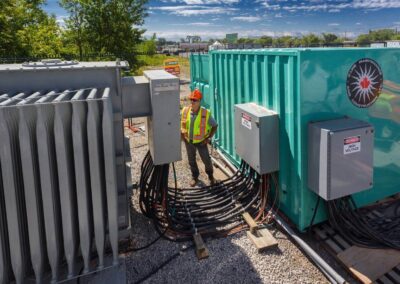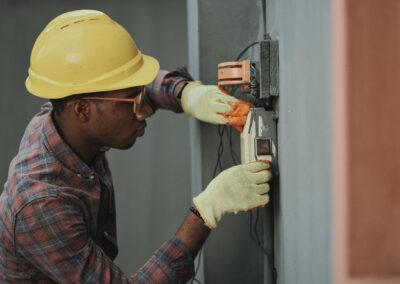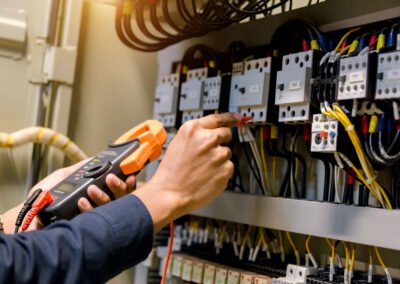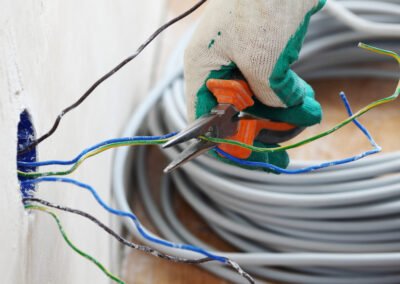Mobile Commercial Wiring, Markham
Though electrical wiring in a residential facility is a fairly straightforward procedure, wiring for a commercial property is usually more complex, and requires the expertise of a skilled and knowledgeable electrician.
Request InformationSchedule Service
Mobile Commercial Wiring, Markham
Safety should always come first in all electrical tasks, including wiring. For both commercial and residential structures, electrical wiring may be a challenging task. It is best left to the expertise and experience of a certified electrical contractor to carry out the job securely and in compliance with the Electrical Safety Authority’s (ESA) electrical code. Although completing electrical work in residential and commercial spaces is similar, wiring in commercial spaces takes extra caution since the wiring must be set up to account for any heavy tools and machinery present in the space.
The three main methods used for electrical wiring in commercial facilities are cable assemblies, raceways and conductors, and busways.
Cable Assemblies
The use of a cable assembly is extremely common when it comes to electrical wiring in a commercial setting. Many insulated and neutral phase conductors can be found in the cable assemblies’ equipment grounding wire. Custom cable assemblies are available and commonly include copper or aluminium conductors that are either THHN/THWN (thermoplastic high heat-resistant nylon jacket) or XHHW-2 (XLPE high heat-resistant and water-resistant nylon jacket).
In comparison to traditional wiring methods, using cable assemblies provides a few advantages, such as flexible cable routing, lower installation costs, and speedier installation timeframes. The consequence of being unable to change the circuit configuration after it has been installed is that it requires more planning before installation.
Raceways and Conductors
The raceway and conductor approach is another widely employed strategy. When employing raceways and conductors, a tube or conduit with an equipment grounding conductor and several insulated phases is often used. As with any type of electrical project, the actual design and installation will vary depending on the demands and requirements of the commercial property. Copper/aluminum conductor types THHN/THWN or XHHW are the most often used conductor kinds, similar to cable assemblies. Typically, branch circuits are built of copper while feeders are made of aluminium.
Raceways and conductors have the advantage of permitting modifications in circuit arrangement in comparison to the cable assembly method, and raceways are easy to use for remodelling projects. However, some disadvantages include higher installation costs in contrast to other wiring systems and a difficult installation process due to stringent routing requirements.
Busways
The third most common method for commercial wiring is a busway, which is an enclosed raceway with busbars. In most cases, busways are plug-in or feeder designs that can handle insulated or bare wires. The busway method has a number of benefits, including the fact that it is smaller and more compact than many conduits and is available in ampere levels ranging from 60 to 4,000 A. Furthermore, the total voltage loss is less of an issue with busways. Conversely, the busway technique has a few disadvantages, such as a higher installation cost and a propensity for busways to collapse if there are any water leaks inside the building. Moreover, there might not be enough space.
Despite the fact that these three commercial wiring methods are the most common, there may be more possibilities. At Made Electric, we can guide you through all of your wiring options and provide advice on how to set up your commercial property most effectively. Please don’t hesitate to get in touch with MADE ELECTRIC right away! We provide excellent service in both commercial and residential settings because to our years of experience and ESA licence. Our team is situated in Markham and the GTA, and we are committed to helping you with all of your wiring needs.
Frequently Asked Questions (FAQs)
How does commercial electrical rewiring differ from residential electrical wiring?
While most residential projects require single phase power, commercial wiring typically uses 3-phase power. Residential electricians can work on electrical systems which are smaller than commercial systems, with a voltage as high as 240V, while commercial electricians work on wiring systems which are much larger and complex.
Which electrical wiring method is best for my commercial property?
The three main methods for electrical wiring in commercial spaces are raceways and conductors, busways and cable assemblies. If you are unsure of which method is best for your property, don’t hesitate to contact us and we can advise and guide you through the installation process.
Are there other types of wiring methods for commercial properties?
The three main methods for wiring commercial properties (raceways and conductors, busways and cable assemblies) are the most commonly used methods in industry. However, alternate configurations are possible, and we will work with you to find a custom configuration that suits your property best.




